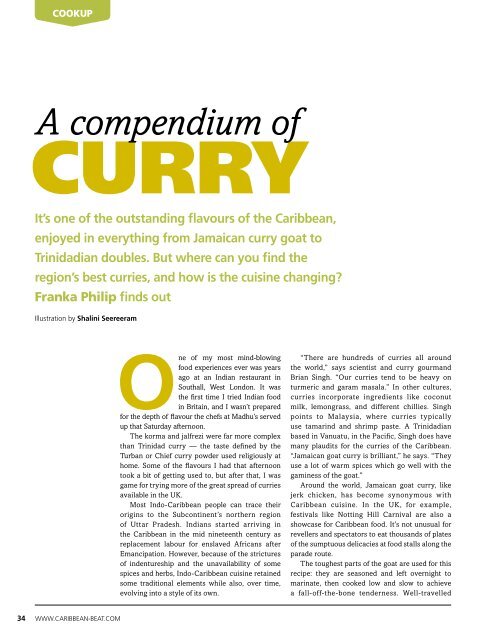Caribbean Beat — 25th Anniversary Edition — March/April 2017 (#144)
A calendar of events; music, film, and book reviews; travel features; people profiles, and much more.
A calendar of events; music, film, and book reviews; travel features; people profiles, and much more.
Create successful ePaper yourself
Turn your PDF publications into a flip-book with our unique Google optimized e-Paper software.
cookup<br />
A compendium of<br />
curry<br />
It’s one of the outstanding flavours of the <strong>Caribbean</strong>,<br />
enjoyed in everything from Jamaican curry goat to<br />
Trinidadian doubles. But where can you find the<br />
region’s best curries, and how is the cuisine changing?<br />
Franka Philip finds out<br />
Illustration by Shalini Seereeram<br />
One of my most mind-blowing<br />
food experiences ever was years<br />
ago at an Indian restaurant in<br />
Southall, West London. It was<br />
the first time I tried Indian food<br />
in Britain, and I wasn’t prepared<br />
for the depth of flavour the chefs at Madhu’s served<br />
up that Saturday afternoon.<br />
The korma and jalfrezi were far more complex<br />
than Trinidad curry <strong>—</strong> the taste defined by the<br />
Turban or Chief curry powder used religiously at<br />
home. Some of the flavours I had that afternoon<br />
took a bit of getting used to, but after that, I was<br />
game for trying more of the great spread of curries<br />
available in the UK.<br />
Most Indo-<strong>Caribbean</strong> people can trace their<br />
origins to the Subcontinent’s northern region<br />
of Uttar Pradesh. Indians started arriving in<br />
the <strong>Caribbean</strong> in the mid nineteenth century as<br />
replacement labour for enslaved Africans after<br />
Emancipation. However, because of the strictures<br />
of indentureship and the unavailability of some<br />
spices and herbs, Indo-<strong>Caribbean</strong> cuisine retained<br />
some traditional elements while also, over time,<br />
evolving into a style of its own.<br />
“There are hundreds of curries all around<br />
the world,” says scientist and curry gourmand<br />
Brian Singh. “Our curries tend to be heavy on<br />
turmeric and garam masala.” In other cultures,<br />
curries incorporate ingredients like coconut<br />
milk, lemongrass, and different chillies. Singh<br />
points to Malaysia, where curries typically<br />
use tamarind and shrimp paste. A Trinidadian<br />
based in Vanuatu, in the Pacific, Singh does have<br />
many plaudits for the curries of the <strong>Caribbean</strong>.<br />
“Jamaican goat curry is brilliant,” he says. “They<br />
use a lot of warm spices which go well with the<br />
gaminess of the goat.”<br />
Around the world, Jamaican goat curry, like<br />
jerk chicken, has become synonymous with<br />
<strong>Caribbean</strong> cuisine. In the UK, for example,<br />
festivals like Notting Hill Carnival are also a<br />
showcase for <strong>Caribbean</strong> food. It’s not unusual for<br />
revellers and spectators to eat thousands of plates<br />
of the sumptuous delicacies at food stalls along the<br />
parade route.<br />
The toughest parts of the goat are used for this<br />
recipe: they are seasoned and left overnight to<br />
marinate, then cooked low and slow to achieve<br />
a fall-off-the-bone tenderness. Well-travelled<br />
34 WWW.CARIBBEAN-BEAT.COM


















